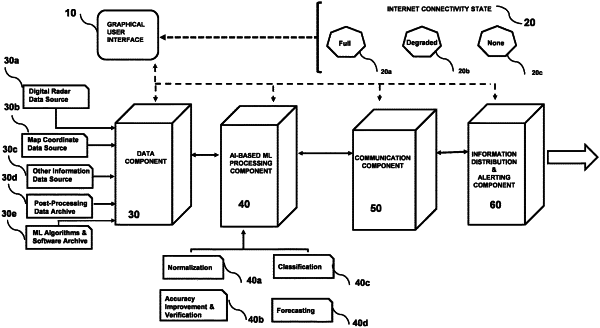| CPC G01S 13/589 (2013.01) [G06F 18/24 (2023.01); G06N 20/00 (2019.01)] | 18 Claims |

|
1. A system for generating an artificial intelligence-enhanced real-time, multi-dimensional gridded aerial object classification and vector forecast for one or more manned and unmanned aerial objects operating at subsonic, sonic, supersonic, or hypersonic speeds within a target grid, the system utilizing digital radar signals data and comprising:
a data component including a data cache containing real-time or near real time pre-processed and post-processed digital radar signals data, including interpolated digital radar signals data, and archived endogenous information including prior pre-processed and post-processed digital radar signals data, position constant georeferenced x, y & z coordinates, previously discarded digital radar signals data, prior multi-dimensional gridded aerial object classifications and vector forecast predictions, and map coordinates stored in an array, each element of the array being time-referenced and geo-referenced, the data cache further comprising software containing machine learning algorithms;
an artificial intelligence machine learning processing component including a normalization module, an accuracy improvement and verification module, a classification module, and a forecasting module and associated logic for manipulating the data cache to generate the multi-dimensional gridded aerial object classification and vector forecast, the multi-dimensional gridded aerial object classification and vector forecast including a confidence value;
an information distribution and alerting component arranged to receive the multi-dimensional gridded aerial object classification and vector forecast and present the multi-dimensional gridded aerial object classification and vector forecast in accordance with a predetermined end user requirement;
a communications component arranged to receive data requests from the artificial intelligence machine learning process component, transmit the data requests to the data component, receive requested data from the data component, and transmit the requested data to the artificial intelligence machine learning process component, the communications component further arranged to transmit the multi-dimensional gridded aerial object classification and vector forecast the predictions to the information distribution and alerting component; and
a computer-implemented graphical user interface in communication with the data component, the artificial intelligence machine learning processing component information distribution and alerting component, and the communications component, the computer-implemented graphical user interface adapted to display the multi-dimensional gridded aerial object classification and vector forecast;
wherein when the system has full internet connectivity, the real-time or near-real time pre-processed and post-processed digital radar signals data is used for initial input from the data component to populate the artificial intelligence machine learning processing component; and
wherein when the system has degraded internet connectivity, a subset of the real-time or near real time pre-processed and post-processed digital radar signals data, if available, and the endogenous archived information are used for initial input from the data component to populate the artificial intelligence machine learning processing component; and
wherein when the system has no internet connectivity, only the endogenous archived information and the position constant georeferenced x, y & z coordinates are used for initial input from the data component to populate the artificial intelligence machine learning processing component.
|